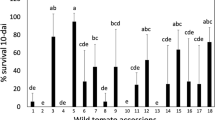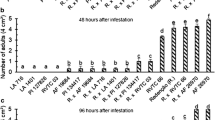Abstract
Orobanche and Phelipanche, commonly known as broomrape, are dicotyledonous holoparasitic flowering plants that cause heavy economic losses in a wide variety of plant species. Breeding for Orobanche resistance is still one of the most effective management strategies for this weed. However, previous efforts to find broomrape-resistant tomato (Solanum lycopersicon) genotypes have been unsuccessful. Here, we report on the isolation and characterization of a fast-neutron-mutagenized M-82 tomato mutant, Sl-ORT1. The Sl-ORT1 mutant showed resistance to Phelipanche aegyptiaca as compared to cultivar M-82; segregation analysis suggested a single recessive ort1 allele. Sl-ORT1 broomrape resistance was reflected in a lower number of broomrapes per plant, reduced P. aegyptiaca fresh weight per plant, and the absence of broomrape’s negative effect on plant host growth and yield. Sl-ORT1 was shown to be resistant to high concentrations of P. aegyptiaca seeds, and to another three broomrape species: Phelipanche ramosa, Orobanche cernua, and Orobanche crenata. Grafting experiments demonstrated that roots, rather than shoots, are necessary for Sl-ORT1 broomrape resistance. In addition, Sl-ORT1 was shown to be resistant to broomrape under field conditions. Since yield parameters are slightly affected by the mutation, this resistance gene should be introduced into tomato varieties with different genetic backgrounds; this newly identified Orobanche-resistant mutant may be further utilized in breeding programs for Orobanche resistance.








Similar content being viewed by others
References
Abu-Gharbieh WI, Makkouk KM, Saghir AR (1978) Responses of different tomato cultivars to the root-knot nematode, tomato yellow leaf curl virus, and Orobanche in Jordan. Plant Dis Rep 62:263–266
Avdeyev YI, Scherbinin BM (1977) Tomato resistant to broomrape, Orobanche aegyptiaca. Report of the tomato genetics cooperative, department of vegetative crops, University of California, Davis, Report No 27
Avdeyev YI, Scherbinin BM, Ivanova LM, Avdeyev AY (2003) Studying of tomato resistance to broomrape and breeding varieties for processing. In: Bieche B, Branthome X (eds) VIIIth international symposium on the processing tomato. International society for horticultural science. Acta Hortic 613:283–290
Dalela GG, Mathur RL (1971) Resistance of varieties of eggplant tomato and tobacco to broomrape (Orobanche cernua Loef.). PANS 17:482–483
Dörr I, Staack A, Kollmann R (1994) Resistance of Helianthus to Orobanche—histological and cytological studies. In: Pieterse AH, Verkleij JAC, ter Borg SJ (eds) Biology and management of Orobanche, proceedings of the third international workshop on Orobanche and related Striga research. Amsterdam Royal Tropical Institute, Amsterdam, pp 276–289
El-Halmouch Y, Benharrat H, Thalouran P (2006) Effect of root exudates from different tomato genotypes on broomrape (O. aegyptiaca) seed germination and tubercle development. Crop Prot 25:501–507
Fernández-Martínez J, Melero-Vara J, Muñoz-Ruz J, Ruso J, Domínguez J (2000) Selection of wild and cultivated sunflower for resistance to a new broomrape race that overcomes resistance of the Or (5) gene. Crop Sci 40:550–555
Foy CL, Jacobsohn R, Jain R (1987) Evaluation of tomato lines for resistance to glyphosate and/or Orobanche aegyptiaca Pers. In: Weber HC, Forstreuter W (eds) Parasitic flowering plants, Proceeding of the 4th ISPFP. Marburg, Germany, pp 221–230
Foy CL, Jacobsohn R, Jain R (1988) Screening of Lycopersicon spp for glyphosate and/or Orobanche aegyptiaca Pres. resistance. Weed Res 28:383–391
Goldwasser Y, Hershenhorn J, Plakhine D, Kleifeld Y, Rubin B (1999) Biochemical factors involved in vetch resistance to Orobanche aegyptiaca. Physiol Mol Plant Pathol 54:87–96
Gurney AL, Grimanelli D, Kanampiu F, Hoisington D, Scholes JD, Press MC (2003) Novel sources of resistance to Striga hermonthica in Tripsacum dactyloides, a wild relative of maize. New Phytol 160:557–568
Hershenhorn J, Eizenberg H, Dor E, Kapulnik Y, Goldwasser Y (2009) Phelipanche aegyptiaca management in tomato. Weed Res 49:1–14
Joel DM, Portnoy VH (1998) The angiospermous root parasite Orobanche L (Orobanchaceae) induces expression of a pathogenesis related (PR) gene in susceptible tobacco roots. Ann Bot 81:779–781
Joel DM, Hershenhorn J, Eizenberg H, Aly R, Ejeta G, Rich PJ, Ransom JK, Sauerborn J, Rubiales D (2007) Biology and management of weedy root parasites. In: Janick J (ed) Horticultural reviews, vol 33. Wiley, Hoboken, pp 267–349
Jorrín J, Pérez-de-Luque A, Serghini K (1999) How plants defend themselves against root parasitic angiosperms: molecular studies with Orobanche spp. In: Cubero JI, Moreno MT, Rubiales D, Sillero JC (eds), Resistance to Orobanche: the state of the art Sevilla, Spain Junta de Andalucía, pp 9–15
Koltai H, Dor E, Hershenhorn J, Joel DM, Weininger S, Lekalla S, Shealtiel H, Bahattacharya C, Eliahu E, Resnick N, Barg R, Kapulnik Y (2009) Strigolactones’ effect on root growth and root-hair elongation may be mediated by auxin-efflux carriers. J Plant Growth Regul (in press)
Kostov K, Batchvarova R, Slavov S (2007) Application of chemical mutagenesis to increase the resistance of tomato to Orobanche ramosa. BJAS 13:505–513
Labrousse P, Arnaud MC, Serieys H, Bervillé A, Thalouran P (2001) Several mechanisms are involved in resistance of Helianthus to Orobanche cumana Wallr. Ann Bot 88:859–868
Lejeune A, Constant S, Delavault P, Simier P, Thalouran P, Thoiron P (2006) Involvement of a putative Lycopersicon esculentum wall-associated kinase in the early steps of tomato-Orobanche ramosa interaction. Physiol Mol Plant Pathol 69:3–12
Mohamed A, Rich PJ, Housley TL, Ejeta (2001) In vitro techniques for studying mechanisms of Striga resistance in sorghum. In: Fer A, Thalouran P, Joel DM, Musselman LJ, Parker C, Verkleij JAC (eds) Proceedings of the 7th International parasitic weed symposium, pp 96–101. Nantes, France, 5–8 June 2001
Nassib AM, Ibrahim AA, Khalil SA (1982) Breeding for resistance to Orobanche. In: Hawtin G, Webb C (eds) Faba bean improvement. Martinus Nijhoff, The Hague, pp 199–206
Pérez-de-Luque A, Jorrin JV, Cubero JI, Rubiales D (2005a) Resistance and avoidance against Orobanche crenata in pea (Pisum spp.) operate at different developmental stages of the parasite. Weed Res 45:379–387
Pérez-de-Luque A, Rubiales D, Cubero JI, Press MC, Scholes J, Yoneyama K, Takeuchi Y, Plakhine D, Joel DM (2005b) Interaction between Orobanche crenata and its host legumes: unsuccessful haustorial penetration and necrosis of the developing parasite. Ann Bot 95:935–942
Pérez-de-Luque A, González-Verdejo CI, Lozano MD, Dita MA, Cubero JI, González-Melendi P, Risueño MC, Rubiales D (2006a) Protein cross-linking, peroxidase and b-1, 3-endoglucanase involved in resistance of pea against Orobanche crenata. J Exp Bot 57:1461–1469
Pérez-de-Luque A, Lozano MD, Cubero JI, Gonzàlez-Melendi P, Risueño MC, Rubiales D (2006b) Mucilage production during the incompatible interaction between Orobanche crenata and Vicia sativa. J Exp Bot 57:931–942
Pérez-Vich B, Akhtouch B, Knapp SJ, León AJ, Velasco L, Fernández-Martínez JM, Berry ST (2004) Quantitative trait loci for broomrape (Orobanche cumana Wallr.) resistance in sunflower. Theor Appl Genet 109:92–102
Qasem JR, Kasrawi MA (1995) Variation of resistance to broomrape (Orobanche ramosa) in tomatoes. Euphytica 81:109–114
Rispail N, Dita M-A, González-Verdejo C, Pérez-de-Luque A, Castillejo MA, Prats E, Román B, Jorrín J, Rubiales D (2007) Plant resistance to parasitic plants: molecular approaches to an old foe. New Phytol 173:703–712
Román B, Torres AM, Rubiales D, Cubero JI, Satovic Z (2002) Mapping of quantitative trait loci controlling broomrape (Orobanche crenata Forsk.) resistance in faba bean (Vicia faba L.). Genome 45:1057–1063
Rubiales D, Pérez-de-Luque A, Joel DM, Alcántara C, Sillero JC (2003a) Characterization of resistance in chickpea to crenate broomrape (Orobanche crenata). Weed Sci 51:702–707
Rubiales D, Pérez-de-Luque JI, CuberoJI Sillero JC (2003b) Crenate broomrape (Orobanche crenata) infection in field pea cultivars. Crop Prot 22:865–872
Rubiales D, Alcántara C, Joel DM, Pérez-de-Luque A, Sillero JC (2003c) Characterization of the resistance to Orobanche crenata in chickpea. Weed Sci 51:702–707
Rubiales D, Fernandez-Aparicio M, Pérez-de-Luque A, Castillejo MA, Prats E, Sillero JC, Rispail N, Fondevilla S (2009) Breeding approaches for crenata broomrape (Orobanche crenata Forsk.) management in pea (Pisum sativum L.). Pest Manag Sci 65:553–559
Serghini KA, Pérez-de-Luque A, Castejόn Muñoz M, Garcia-Torres L, Jorrin JV (2001) Sunflower (Helianthus annuus L.) response to broomrape (Orobanche cernua Loefl.) parasitism: induced synthesis and excretion of 7-hydroxylated simple coumarins. J Exp Bot 52:2227–2234
Sillero JC, Cubero JI, Fernández-Aparicio M, Rubiales D (2005) Search for resistance to crenate broomrape (Orobanche crenata) in Lathyrus. Lathyrus Lathyrism Newslett 4:224–227
Torres AM, Román B, Avila CM, Satovic Z, Rubiales D, Sillero JC, Cubero JI, Moreno MT (2006) Faba bean breeding for resistance against biotic stresses: towards application of marker technology. Euphytica 147:67–80
Valderrama MR, Román B, Satovic Z, Rubiales D, Cubero JI, Torres AM (2004) Locating quantitative trait loci associated with Orobanche crenata resistance in pea. Weed Res 44:323–328
Van-Harten AM (1998) Mutation breeding: theory and practical applications. Cambridge University Press, Cambridge
Acknowledgments
This project was partially supported by a grant from The Chief Scientist, Ministry of Agriculture in Israel to JH and YK, and by Zeraim Gedera Ltd., Israel
Author information
Authors and Affiliations
Corresponding author
Rights and permissions
About this article
Cite this article
Dor, E., Alperin, B., Wininger, S. et al. Characterization of a novel tomato mutant resistant to the weedy parasites Orobanche and Phelipanche spp.. Euphytica 171, 371–380 (2010). https://doi.org/10.1007/s10681-009-0041-2
Received:
Accepted:
Published:
Issue Date:
DOI: https://doi.org/10.1007/s10681-009-0041-2




